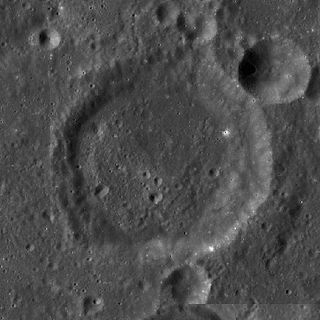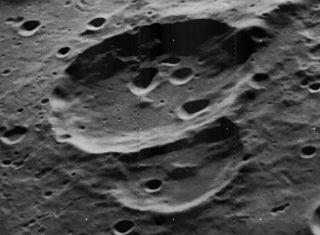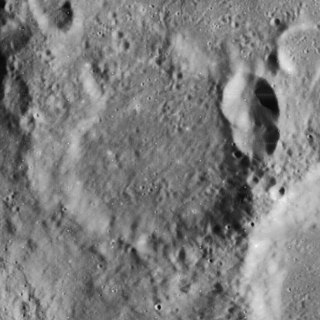
]

Almanon is a lunar impact crater that lies in the rugged highlands in the south-central region of the Moon. It was named after Abbasid Caliph and astronomer Al-Ma'mun. It is located to the south-southeast of Abulfeda, and to the north-northeast of the smaller crater Geber. The crater chain designated Catena Abulfeda forms a line between the south rim of Abulfeda and the north rim of Almanon, continuing for a length of about 210 kilometers to the Rupes Altai scarp.

Apianus is a lunar impact crater that is located on the rugged south-central highlands of the Moon. It is named after 16th century German mathematician and astronomer Petrus Apianus. It is located to the northeast of the crater Aliacensis, and to the northwest of Poisson. The worn crater Krusenstern is attached to the west-northwestern rim.

Baillaud is a lunar impact crater that is located near the north limb of the Moon. The rim of the crater has been eroded and worn by a long history of impacts, leaving a hilly ridge surrounding the interior. The crater Euctemon is intruding into the rim to the northeast, and the rim bulges outward to the northwest. At the south end of the crater is a gap connecting to the lava-flooded surface to the south.

Brianchon is a lunar impact crater that is located along the northwestern limb of the Moon. Due to its location, from the Earth the crater is seen from the edge and its visibility is somewhat affected by libration. Thus for a more detailed view, the crater must be viewed from orbit.

Boltzmann is an old lunar impact crater that is located along the southern limb of the Moon, in the vicinity of the south pole. At this location the crater is viewed from the side from Earth, and so not much detail can be seen. It is located to the north of the walled plain Drygalski, and to the west of the crater Le Gentil.
Mutus is a lunar impact crater that is located in the rugged southern part of the Moon. It lies to the north-northeast of the larger crater Manzinus, and some distance to the south of Hommel. It is 78 kilometers in diameter and 3.7 kilometers deep. It is from the Pre-Nectarian period, 4.55 to 3.92 billion years ago.

De La Rue is the remnant of a lunar impact crater, or possibly several merged craters, creating a formation sometimes called a walled plain. It lies in the northeastern part of the Moon on the near side, and so appears foreshortened due to its location. This formation lies to the north-northwest of the prominent crater Endymion, just beyond the eastern extreme of Mare Frigoris. The crater Strabo intrudes into the northern part of De La Rue's northern rim, and the smaller Thales is attached to the northwestern part of the wall.

Fabry is a large lunar impact crater of the form termed a walled plain. It is located on the far side of the Moon, just beyond the northeastern limb. Parts of this area are sometimes brought into view by the effects of libration, but the terrain is seen from the edge and so not much in the way of detail can be observed.

Curtius is a lunar impact crater that is located in the southern part of the Moon. From the Earth the crater appears foreshortened, making it more difficult to observe detail. Nevertheless, this is a large crater that can be readily found in even small telescopes. Curtius is located within one crater diameter of the still-larger Moretus to the southwest. To the northeast is the smaller Pentland. Curtius is 95 kilometers in diameter and 6.8 kilometers deep. It is from the Nectarian period, 3.92 to 3.85 billion years ago.

Casatus is a lunar impact crater that is located near the southern limb of the Moon. The north-northeast rim of the crater overlies a portion of the slightly larger crater Klaproth. Along the western rim, Casatus A intrudes somewhat into the interior, producing an inward-bowing rim. To the southeast of Casatus is Newton.

Mercurius is a lunar impact crater that is located in the northeastern part of the Moon. It lies to the northeast of the smaller crater Carrington, and west-northwest of Zeno. Just to the south is the small lunar mare named Lacus Spei, and to the west is the larger Lacus Temporis.

Licetus is a lunar impact crater on the near side of the Moon, in the rugged southern highland region. It lies to the south of the walled plain Stöfler, and is attached to the northern rim of the sub-divided crater Heraclitus. Just to the southeast is Cuvier. Licetus is 75 kilometers in diameter and 3.8 kilometers deep. It is from the Pre-Nectarian period, 4.55 to 3.92 billion years ago.

Chaffee is a lunar impact crater that is located in the southern hemisphere on the far side of the Moon. It lies within the huge walled plain Apollo, and is one of several craters in that formation named for astronauts and people associated with the Apollo program. This basin is a double-ringed formation, and the crater Chaffee is situated across the southwest part of the inner ring. The ridge from this ring extends northward from the northern rim of Chaffee.

Lyman is a lunar impact crater that lies in the southern hemisphere on the far side of the Moon. It is located to the south of the huge walled plain Poincaré, and to the northeast of Schrödinger, another walled plain. To the east-southeast is the larger crater Minnaert.

Nearch is a lunar impact crater that is located in the southeastern part of the Moon, to the southeast of the crater Hommel. North of Nearch is Vlacq, and to the northeast lies Rosenberger. The crater is 76 kilometers in diameter and 2.9 kilometers deep. It is from the Pre-Nectarian period, 4.55 to 3.92 billion years ago.

Cockcroft is a lunar impact crater that is situated on the far side of the Moon from the Earth, so that it has only be observed and photographed from orbit. It lies to the northeast of the larger crater Fitzgerald, and southeast of Evershed.

Krusenstern is a lunar impact crater that lies amidst the battered terrain in the southern part of the Moon's near side. Nearly attached to the east-southeast rim is the crater Apianus. Less than one crater diameter to the southwest is the prominent Werner. Krusenstern is intruding into a large circular plain to the north designated Playfair G. Playfair itself lies to the northeast.

Fowler is a large lunar impact crater that lies in the northern hemisphere on the Moon's far side. It lies to the south-southwest of the crater Esnault-Pelterie, and north of Gadomski. Overlying the eastern rim and intruding into the interior is Von Zeipel.

Razumov is an impact crater on the far side of the Moon, beyond the northwestern limb as seen from the Earth. It lies along the southeastern outer rim of the walled plain Landau. Intruding slightly into the southern rim is the slightly smaller crater Petropavlovskiy. To the west-southwest lies Frost.

























